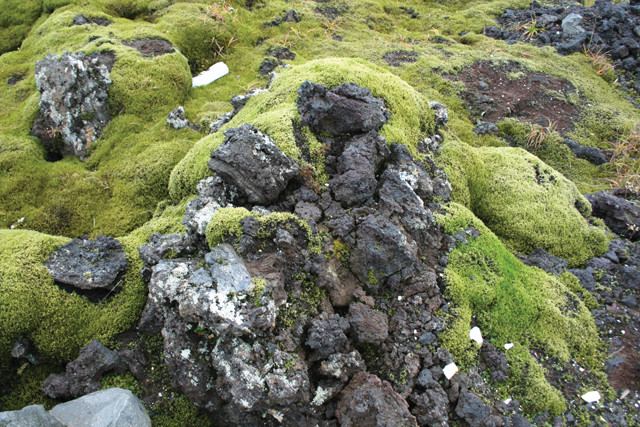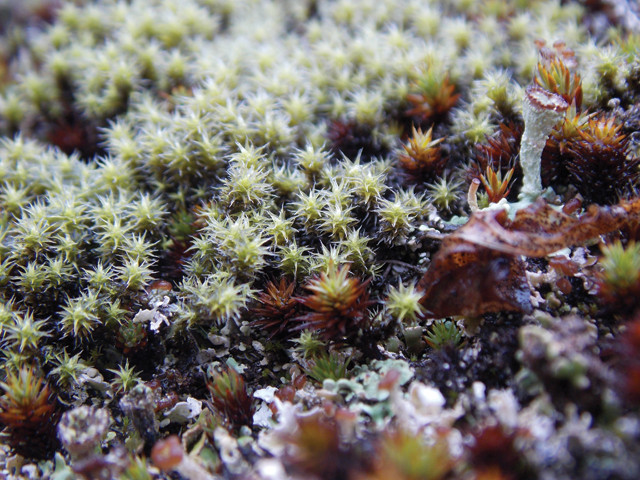
by Bethany Augliere Wednesday, January 25, 2017

Moss carpets colonize recent lava flows in southern Iceland. Credit: Ria Mitchell.
Moss, the springy green plant that blankets forest floors, has been heralded as the generator of large amounts of oxygen to Earth’s atmosphere during the Paleozoic. In a new study, however, researchers suggest that it could have been the overlooked relative of moss — liverworts — that dominated early terrestrial ecosystems and thus had more to do with reducing high carbon dioxide levels in the atmosphere at the time and cooling climate globally.

A close-up of a cryptogamic ground cover, a group that includes organisms like mosses, liverworts, algae, fungi and lichens. Credit: Silvia Pressel.
Researchers from the Natural History Museum in London examined how plants living on primitive terrain in Iceland contribute to mineral weathering and soil formation. “A lot of work has been done previously on weathering rates by some of these organisms, but nobody has really looked at how they weather [rock and soil],” says Ria Mitchell, a sedimentologist at the museum and lead author of the new study in Geology. By doing so, Mitchell and her team could then use the plants and environments they studied as modern analogues to better understand ancient soils and early terrestrial ecosystems.
Liverworts and mosses belong to a group of plants called bryophytes, which lack true roots and the specialized tissues that transport water and other nutrients in most plants. Together with fungi, bacteria, algae and lichens, mosses and liverworts make up what are called cryptogamic ground covers. Before forests, these primitive plants and microbes dominated terrestrial landscapes.
Mitchell and her colleagues collected soil cores from pristine habitats on volcanic terrain in Iceland, where any alterations to underlying rock and soil were due to the organisms growing on the surface. It can be difficult to find environments where roots from former trees and shrubs have not influenced soil weathering, says Martin Gibling, a sedimentologist at Dalhousie University in Nova Scotia, Canada, who was not involved in the study. “They made the case nicely that these were relatively young environments and there were no signs of anything other than the ground covers,” he says.
The cores were roughly 8 centimeters deep and included the layer of surface organisms as well as the underlying soil. The team used X-ray micro-computed tomography techniques to examine the three-dimensional soil structure in the cores, scanning electron microscopy to image individual mineral grains, and X-ray diffraction to determine clay compositions in the soil. Altogether, these techniques enabled fine-scale analysis of soil weathering at the locations sampled.
Mitchell and her colleagues found that plant type and growth strategy affected soil structure. Soil thicknesses beneath mosses were deeper than those beneath liverworts — averaging 35 millimeters and 15 millimeters, respectively — and less dense. Liverworts are more primitive than mosses, with relatively shorter rhizoids, hair-like projections that root the plant. But some species have an advantage by acquiring fungal and cyanobacteria symbionts. Fungal symbionts extend the plants’ rooting networks and hold the soil together more tightly, but also aid in weathering, as the fungi attach to and bore into mineral grains to obtain essential nutrients for the host plant. Mosses lack these relationships, and thus, cannot contribute to weathering in the same manner, Mitchell says.
The upright growth of the moss, like a tree, also means that fine soil grains can get caught within its spongy structure, progressively burying the moss and leading to thicker, more organic-rich soil. In contrast, liverworts grow more laterally, do not get buried, and their rhizoids only hold the top few millimeters of soil in place. “Soil thickness, we think, is governed by rhizoid interaction and penetration depth — thin in liverworts, thicker in mosses,” Mitchell says.
The researchers also found indications of organisms causing micron-scale weathering in mineral grains. For instance, they found tunnels, grooves and trenches dug on the surface of soil mineral grains likely caused by fungi, and bowl-shaped depressions from bacterial weathering. This biotic weathering contributes to the destruction of minerals and ultimately, soil formation, Mitchell says. “These tiny, little — what many people would think insignificant — plants and organisms do actually leave a mark on the mineral grains,” she says, noting that she would next like to determine which organisms specifically are leaving the different features. “Like fingerprints, we think these marks on the minerals could be used as a way of recognizing the presence of organisms in the geological record when their organic remains are not preserved,” Mitchell says.
One of the most exciting results, though, was finding clays beneath the liverwort Blasia pusilla, Mitchell says. Clay minerals form from the gradual weathering of other minerals in rocks, which means Blasia might have had a hand in weathering soil minerals enough to develop the clays. That’s interesting, she says, because instead of the fungal symbionts typically associated with liverworts, Blasia has a symbiotic relationship with more primitive cyanobacteria. When plants first arrived on land in the Early Paleozoic, it’s possible that they could have been forming symbiotic relationships with cyanobacteria, which could have predated fungal symbiosis. “Cyanobacterial symbiosis might be an overlooked part of this weathering work,” she says.
To determine whether mosses or liverworts were more representative of ancient plant communities, Mitchell and her team compared their samples to an outcrop in Scotland — the Rhynie Chert — an Early Devonian hot-spring deposit that contains the oldest well-preserved land plant ecosystems. Organisms like cyanobacteria, algae, fungi and plants are all preserved in the Rhynie Chert, as well as evidence for fungal and cyanobacterial symbiosis. Liverworts most closely resemble the Rhynie Chert community and represent the best modern analogues in large part due to their fungal and cyanobacterial symbionts, Mitchell says.
The team’s results support liverworts as being active on these very early landscapes, and that wasn’t really known, Gibling says. “That’s a significant advance.”
© 2008-2021. All rights reserved. Any copying, redistribution or retransmission of any of the contents of this service without the expressed written permission of the American Geosciences Institute is expressly prohibited. Click here for all copyright requests.